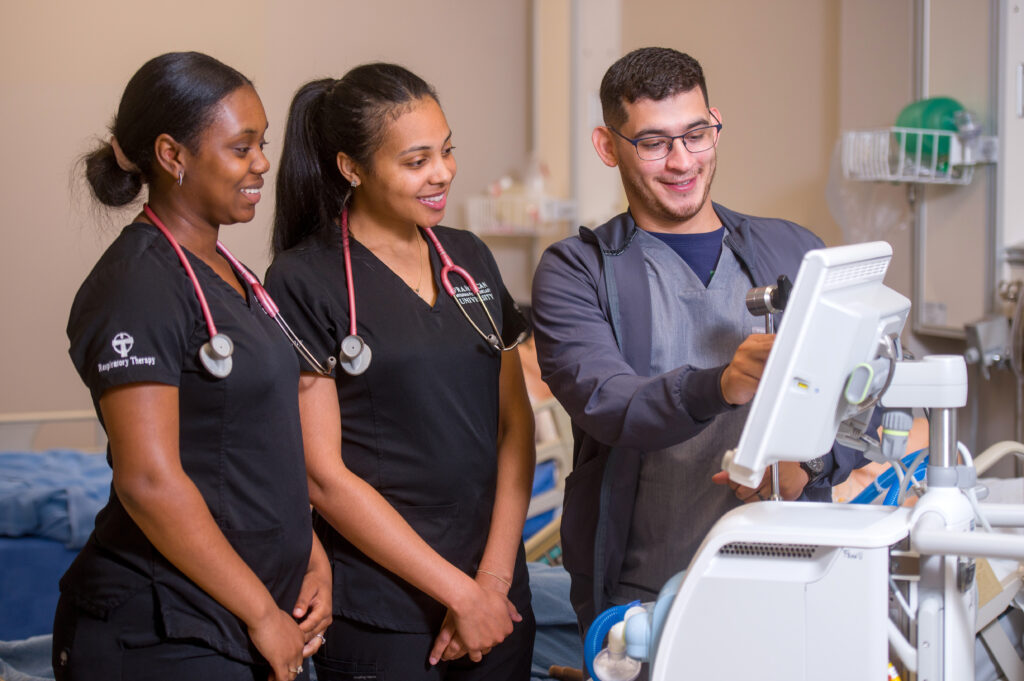Like many of her colleagues and the students at Franciscan Missionaries of Our Lady University, Dr. Tabitha Jones-Thomas is eagerly awaiting the opening of St. Francis Hall—a new building that is currently under construction and will serve as a focal point for the university’s campus.
Inside that facility will be a brand-new Simulated Environment Teaching Hospital, known around FranU as the SETH. Jones-Thomas, who directs this program, says it will open the door to new-and-improved opportunities for students.
High-tech simulators and the hospital-like environments have become an increasingly important component of all health professions curricula, from associate’s degree programs up to the doctoral level. Medical professionals also use the SETH for certification trainings.
“Simulation started out in aviation. They wanted to save lives and have zero mistakes. Becoming proficient in the air with people’s lives at stake was never ideal,” explains Jones-Thomas, associate dean and director of simulated clinical education and associate professor in the School of Nursing. “Healthcare is another place you want to decrease errors. It allows our students to prepare for practice in a safe environment.”
Students get the chance to work with simulators that can emulate all sorts of human functions—like giving birth, having an asthma attack and experiencing congestive heart failure. In some scenarios, live volunteers play the role of patients. The approach has proven successful. Pass rates are up, and students are more confident in their abilities, Jones-Thomas says.
Just like a real hospital where doctors, nurses and other professionals with various specialties must work together to give patients the best care, the SETH fosters collaboration among different disciplines.
“Traditionally, so many different things happen in silos,” she says. “When the team doesn’t know how to collaborate effectively, it can lead to errors.”
Once St. Francis Hall is open, the current 4,000-square-foot SETH will be replaced by a 20,000-square-foot space. The extra room will allow FranU to add more simulated environments—from a radiology room to a NICU to an operating room.
“They are very realistic to their true clinical environment,” Jones-Thomas says. “We’re going to have all the equipment they would use in the real world. For the operating room, we have invested in two simulators that are able to function as a human would with gas exchange. We’ll be able to deliver medical gases, and the simulators will respond just as a human would.”
The SETH also will include an apartment, offering useful training for those seeking careers in home health and other fields where home visits are required and unique safety factors must be taken into consideration.
There will even be a space to brush up on best practices for telemedicine—something that has taken off in recent years. Helping students hone their skills in this growing area of healthcare will make them more marketable when they’re looking for jobs, Jones-Thomas says.
She’s optimistic the expanded SETH space will improve the experience for current and future students alike. “We facilitate tours for high school students and show them the space,” she says. “I love seeing the lightbulbs go off when those students feel like they’ve identified what they’re interested in as a future career.”
Jones-Thomas believes the new simulation spaces will be valuable in FranU’s efforts to ready students to provide services in a caring, conscientious way once they graduate.
“I think the thing that makes us unique is the way in which we prepare our students,” she says. “We prepare Franciscan servant leaders of all faiths. It’s more than teaching students to do a skill. We prepare highly skilled, integrated thinkers and faith-filled citizens.”
